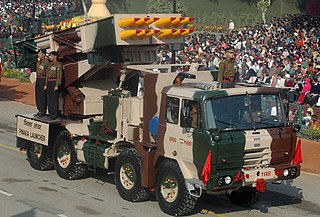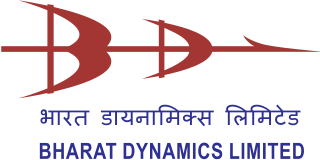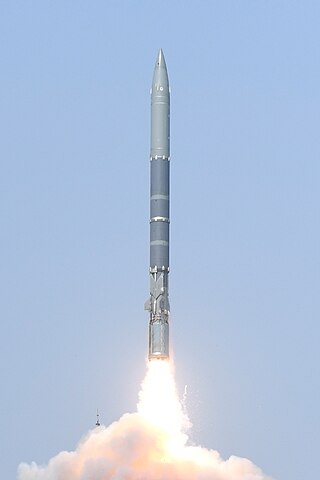
The Agni-III is an Indian intermediate-range ballistic missile inducted into service in 2011 as the successor of the Agni-II. It has a range of 3,500 to 5,000 kilometres and can reach targets deep inside neighbouring countries including PAKISTAN & China.

Prithvi is a tactical surface-to-surface short-range ballistic missile (SRBM) developed by Defence Research and Development Organisation (DRDO) of India under the Integrated Guided Missile Development Program (IGMDP). It is deployed by India's Strategic Forces Command.

The Integrated Guided Missile Development Programme (IGMDP) was an Indian Ministry of Defence programme for the research and development of the comprehensive range of missiles. The programme was managed by the Defence Research and Development Organisation (DRDO) and Ordnance Factories Board in partnership with other Indian government political organisations. The project started in 1982–83 under the leadership of Abdul Kalam who oversaw its ending in 2008 after these strategic missiles were successfully developed.

Akash is a medium-range mobile surface-to-air missile (SAM) system developed by the Defence Research and Development Organisation (DRDO) and produced by Bharat Dynamics Limited (BDL). Surveillance and Fire control radar, tactical control and command center and missile launcher are developed by Bharat Electronics (BEL), Tata Power Strategic Engineering Division and Larsen & Toubro. The Akash missile system can target aircraft up to 45 km (28 mi) away. It has the capability to neutralise aerial targets like fighter jets, cruise missiles and air-to-surface missiles. It is in operational service with the Indian Army and the Indian Air Force.
Trishul is a low-level quick-reaction short range surface-to-air missile developed in India by Defence Research and Development Organisation (DRDO) as part of the Integrated Guided Missile Development Programme (IGMDP). It can also be used as an anti-sea skimmer from naval ship against low flying missile, attack helicopter and aircraft.

Rajendra is a passive electronically scanned array radar developed by the Defence Research and Development Organisation (DRDO). This acts as the Fire-control radar for Akash weapon system. It is a multifunction radar, capable of surveillance, tracking and engaging low radar cross section targets. It is a ground surveillance radar and is a great source of surveillance operating at frequency around 20 GHz. It is mainly used to track enemy's installations.

Pinaka is a multiple rocket launcher produced in India and developed by the Defence Research and Development Organisation (DRDO) for the Indian Army. The system has a maximum range of 40 km for Mark-I and 60 km for Mark-I enhanced version, and can fire a salvo of 12 HE rockets in 44 seconds. The system is mounted on a Tatra truck for mobility. Pinaka saw service during the Kargil War, where it was successful in neutralising Pakistani positions on the mountain tops. It has since been inducted into the Indian Army in large numbers.

Bharat Dynamics Limited (BDL) is one of India's manufacturers of ammunitions and missile systems. It was founded in 1970 in Hyderabad, India. BDL, since its inception, has been working in collaboration with the Defence Research and Development Organisation (DRDO) and foreign original equipment manufacturers (OEMs) for manufacturing and supplying various missiles and allied equipment to the Indian Armed Forces. While fulfilling its basic role as a weapons system manufacturer, BDL has built up in-house R&D capabilities primarily focusing on design and engineering activities. BDL has three manufacturing units, located at Kanchanbagh, Hyderabad; Bhanur, Medak district, and Visakhapatnam, Andhra Pradesh.
The Indian Ballistic Missile Defence Programme is an initiative to develop and deploy a multi-layered ballistic missile defence system to protect India from ballistic missile attacks. It was launched in 2000 after Kargil War by the Atal Bihari Vajpayee government. Testing was carried out and continuing as of 2006, and the system was expected to be operational four years from then according to the head of the country's missiles development programme, Vijay Kumar Saraswat.

The Nag missile, also called "Prospina" for the land-attack version, is an Indian third-generation, all-weather, fire-and-forget, lock-on after launch, anti-tank guided missile (ATGM) with an operational range of 500 m to 20 km depending on variant. It has a single-shot hit probability of 90% and a ten-year, maintenance-free shelf life. The Nag has five variants under development: a land version, for a mast-mounted system; the helicopter-launched Nag (HELINA) also known as Dhruvastra; a "man-portable" version (MPATGM); an air-launched version which will replace the current imaging infra-red (IIR) to millimetric-wave (mmW) active radar homing seeker; and the Nag Missile Carrier (NAMICA) "tank buster", which is a modified BMP-2 infantry fighting vehicle (IFV) produced under license in India by Ordnance Factory Medak (OFMK).
The Maitri missile (Friendship) project was a cancelled proposal for a next-generation quick-reaction surface-to-air missile (QRSAM) with a lethal near-hundred per cent kill probability planned for development by India's Defence Research and Development Organisation. It is a short-range surface-to-air defense missile system.

Barak 8, also known as LR-SAM or MR-SAM, is an Indo-Israeli jointly developed surface-to-air missile (SAM) system, designed to defend against any type of airborne threat including aircraft, helicopters, anti-ship missiles, and UAVs as well as ballistic missiles, cruise missiles and combat jets. Both maritime and land-based variants of the system exist.
India has studied, produced and used various strategic and tactical missile systems since its independence. Decades long projects have realised development of all types of missile systems including ballistic, cruise, anti-ship, air-defence, air-to-air and anti-missile systems. India is one of seven countries in the world with intercontinental ballistic missiles (ICBMs) and one of four countries with anti-ballistic missile systems. Since 2016, India has been a member of Missile Technology Control Regime (MTCR).

The Rudram is a series of air-to-surface ground attack and anti-radiation missiles in development by the Defence Research and Development Organisation of India. It can be launched from a range of altitudes with large standoff distance for destroying enemy surveillance radars, communication stations and bunkers.

Pralay is a canisterised surface-to-surface, short-range ballistic missile (SRBM) for battlefield use developed by the Defence Research and Development Organisation (DRDO) of India. The missile is an amalgamation of technologies developed for exoatmospheric interceptor missile Prithvi Defence Vehicle (PDV) from the Indian Ballistic Missile Defence Programme, and the Prahaar tactical missile. The project to develop Pralay was sanctioned in March 2015 with a budget of ₹332.88 crore.

Akash - New generation abbreviated as Akash-NG is a mid-ranged mobile surface-to-air missile defense system developed by the Defence Research and Development Organisation (DRDO) and produced by Bharat Dynamics Limited (BDL) and Bharat Electronics (BEL).

The Vertical Launch – Short Range Surface to Air Missile, or VL-SRSAM is a quick reaction surface-to-air missile developed by the Indian Defence Research and Development Organisation (DRDO). During mid-course flight, the missile uses fibre-optic gyroscope based inertial guidance mechanism while in terminal phase uses active radar homing. With lock on before launch (LOBL) and lock on after launch (LOAL) capability, the missile receives mid-course update via datalink. VL-SRSAM intended to replace older Barak 1 surface to air missile system onboard Indian Navy warships. It will also be used as short range air defence system for Indian Air Force.

SMART is a canister-based, long-range supersonic anti-submarine missile developed by the Defence Research and Development Organisation (DRDO) for the Indian Navy.
This article consists of projects of the Defence Research and Development Organisation.

The Very Short Range Air Defence System, or VSHORADS, is a fourth generation, man-portable air-defense system (MANPADS) developed by Research Centre Imarat (RCI),a research lab under Defence Research and Development Organisation (DRDO), located in Hyderabad. Multiple DRDO laboratories along with Indian Industry Partners are participating in the project. It is designed for anti-aircraft warfare and neutralising low altitude aerial threats at short ranges.















